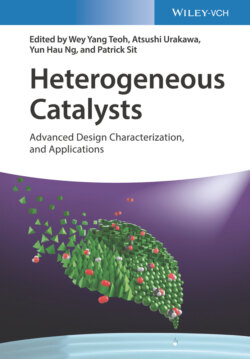Читать книгу Heterogeneous Catalysts - Группа авторов - Страница 36
3.2.2 Cathodic Electrodeposition
ОглавлениеCathodic electrodeposition is another well‐established electrochemical method in fabricating thin films of nanocrystalline metals, alloys, and composite catalysts, where instead of forming the desired oxide layer on the anode as demonstrated in the previous section of anodization method, the targeted materials are now deposited on the cathode through electroreduction of metal cations dissolved in the electrochemical bath. The electrochemical configuration is as shown in Figure 3.1, where precise control over the thickness and composition of the catalyst layer can be achieved either through the control of applied voltage (potentiostatic method) or current (galvanostatic method). It is a low‐temperature synthesis that is typically performed at ambient temperature.
The potentials needed to drive the reduction of metallic cations depend on the redox potential of such targeted metal. In electrodeposition of more than mono‐component, the element with positive reduction potentials will be reduced first as it can receive electrons relatively easier, although the reduction kinetics can be different. However, in principle, a convenient scanning of cathodic voltage over a window of voltage would be sufficient to identify the required potentials.
Electrodeposition is considered a strong method of coating because of their abrasion resistance, hardness, coating adhesion, and corrosion resistance. Furthermore, modulation of the abovementioned properties can be performed through a number of experimental variations including temperature of medium, precursors' concentration, pH of electrolyte, and current density. The higher thickness of coating can also be achieved by simply lengthening the duration of deposition. Because it follows the Faraday's law for electrolysis, a deposited metal (Met) started from its cations (Metz+) under constant current density (I) should follow this relationship:
(3.3)
where x is the film thickness, M is the molar weight of materials, (φ) is current efficiency, ρ is density of the layer, A is deposited space, z is the number of transferred electrons, and F is the Faraday constant. Assuming current efficiency to be 100% with a known current density and knowing the electrode ambience, the film thickness can be established by deposition time. From an engineering perspective, cathodic electrodeposition is extremely versatile and flexible because there are many different metals, alloys, and composites that can be readily deposited in a variety of forms of thin film (e.g. coatings and freestanding sheet).
